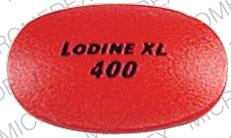Lodine XL Interactions
There are 388 drugs known to interact with Lodine XL (etodolac), along with 10 disease interactions, and 2 alcohol/food interactions. Of the total drug interactions, 100 are major, 280 are moderate, and 8 are minor.
- View all 388 medications that may interact with Lodine XL
- View Lodine XL alcohol/food interactions (2)
- View Lodine XL disease interactions (10)
Most frequently checked interactions
View interaction reports for Lodine XL (etodolac) and the medicines listed below.
- aspirin
- Benadryl (diphenhydramine)
- Celebrex (celecoxib)
- Cymbalta (duloxetine)
- doxycycline
- famotidine
- Fish Oil (omega-3 polyunsaturated fatty acids)
- Flexeril (cyclobenzaprine)
- Flonase (fluticasone nasal)
- Glucosamine & Chondroitin with MSM (chondroitin / glucosamine / methylsulfonylmethane)
- hydrocodone
- hyoscyamine
- ibuprofen
- levothyroxine
- Lipitor (atorvastatin)
- lisinopril
- losartan
- Lyrica (pregabalin)
- meloxicam
- metformin
- omeprazole
- prednisone
- Prozac (fluoxetine)
- Singulair (montelukast)
- Synthroid (levothyroxine)
- tizanidine
- tramadol
- trazodone
- Vitamin D3 (cholecalciferol)
- Zyrtec (cetirizine)
Lodine XL alcohol/food interactions
There are 2 alcohol/food interactions with Lodine XL (etodolac).
Lodine XL disease interactions
There are 10 disease interactions with Lodine XL (etodolac) which include:
- asthma
- fluid retention
- GI toxicity
- rash
- renal toxicities
- thrombosis
- anemia
- hepatotoxicity
- hyperkalemia
- platelet aggregation inhibition
More about Lodine XL (etodolac)
- Lodine XL consumer information
- Compare alternatives
- Drug images
- Latest FDA alerts (4)
- Side effects
- Dosage information
- During pregnancy
- Drug class: Nonsteroidal anti-inflammatory drugs
- Breastfeeding
Related treatment guides
Drug Interaction Classification
| Highly clinically significant. Avoid combinations; the risk of the interaction outweighs the benefit. | |
| Moderately clinically significant. Usually avoid combinations; use it only under special circumstances. | |
| Minimally clinically significant. Minimize risk; assess risk and consider an alternative drug, take steps to circumvent the interaction risk and/or institute a monitoring plan. | |
| No interaction information available. |
See also:
Further information
Always consult your healthcare provider to ensure the information displayed on this page applies to your personal circumstances.


